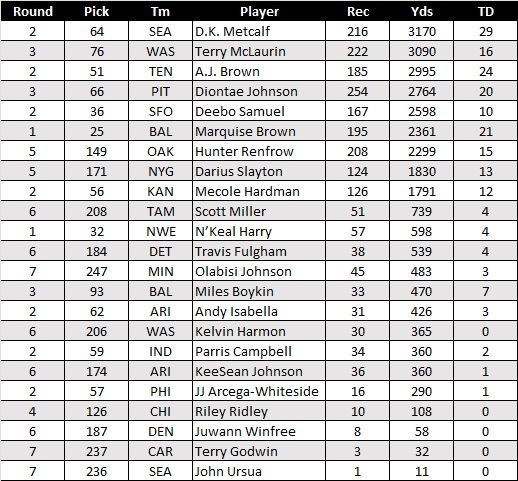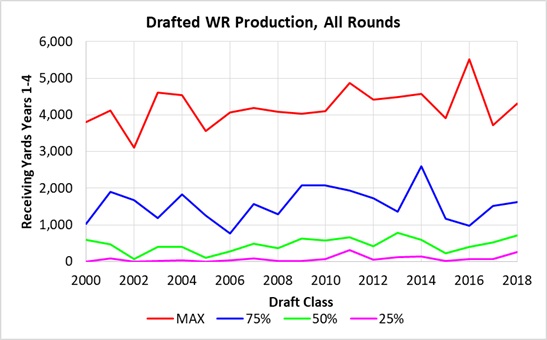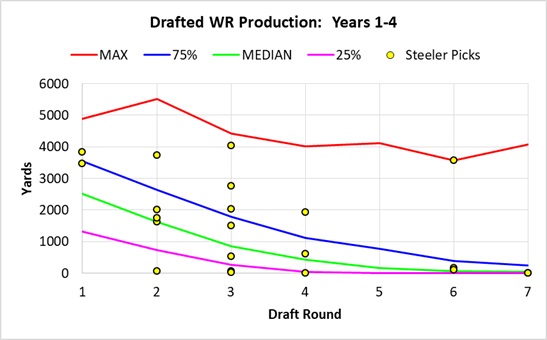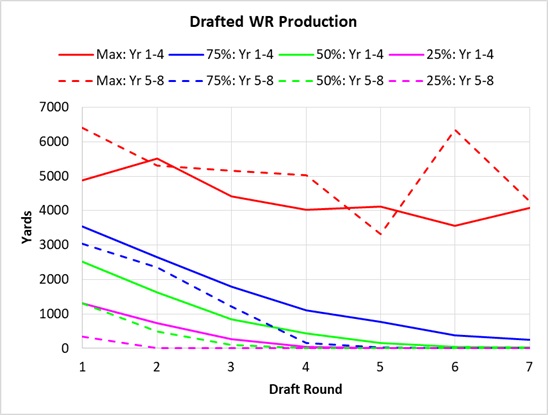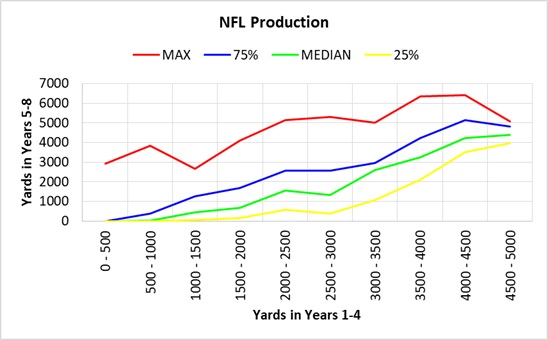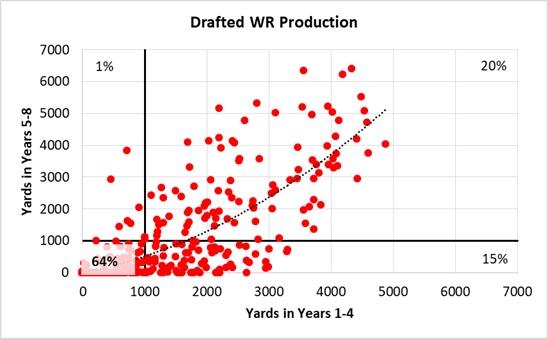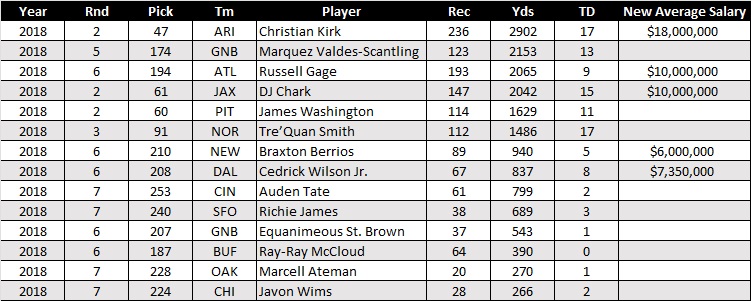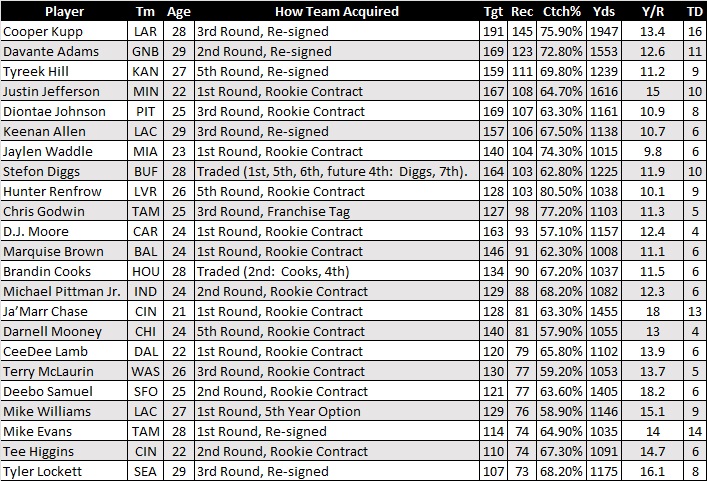Are WRs in the NFL fungible? That’s the question I set out to address in this study. When Diontae Johnson’s possible extension became a more controversial decision among the fan base, I wanted to know how easily WR production was to replace in the NFL. There is not a small group of the fan base who believe that Johnson does not merit the kind of money he is expected to get on his next contract, with many of that group claiming that his production can be easily replaced by a draft pick or a different free agent WR.
First, let’s look at the draft. I decided to focus this study on 4 year production. So for most players, that is the length of their rookie contract.
Johnson put up some good numbers over his first three seasons. Here are all the WRs in his draft class that have caught a pass in the NFL through their first 3 seasons. All stats are courtesy of Pro-Football-Reference, and all contract data is courtesy of Over The Cap.
Johnson is 4th in yards (406 yards behind class leading Metcalf), 1st in receptions (32 more than 2nd place McLaurin), and 4th in TDs with 20. Not bad in what has turned out to be a good draft class of WRs. So now that we know what sort of production he’s had through three seasons, let’s look to the history of the draft and how that stacks up.
These are based on data for WRs drafted from 2000 through 2018, so all of these players have been drafted at least 4 seasons ago. The total receiving yards for each of those players through their first four seasons is plotted. The first graph is for all drafted WRs; the second is based on what round in the draft they were selected. I have broken it down further by the maximum production from a player in that group, the 75th percentile (that means 25% of players produced more, and 75% produced less), the 50th percentile, and the 25th percentile of production. You can also see all of the Steeler’s draft picks plotted there as well.
There is no discernable trend in the WR production by draft year, i.e. WR draft classes have not become more productive in recent years (at least not pre-2018). That’s good, as it makes the historical comparison meaningful.
Something that sticks out to me is that you can clearly find a very productive WR in any round, as the max trend does not decrease much as you progress into the later rounds. You can see the Steelers pick for Antonio Brown there on the max line for round 6. But after that, for the top 25% of WRs in each round, the production steadily declines with the round in which they were selected. The same goes for the other percentile marks. This is probably the most useful chart in this study, as it can help predict the likely production from a WR drafted in a particular round.
It is also noticeable how many of the Steelers’ selections fall at least above the median trend, and many above the 75th percentile trend. This appears to validate that the Steelers have been good at drafting WRs, or at least at getting good production out of the WRs that they draft. Here is a look at all their draft picks in that period.
*Player has not been in the NFL long enough to qualify
In the first round, the Steelers have two selections, both well above median through their first 4 years, and their second 4 years. The second round the history is a little too recent to say too much, but all except Sweed were at least above the median, with Claypool still having two years to climb higher. Randle El had a very nice second four year stint in the league. Something to notice with the later rounds (4 and after) is that players with very modest production through 4 years ranked around the median (not surprising with very few late round WRs being productive), but the following 4 years they rank at the very bottom. That’s because there is a many-way-tie for last place, as a lot of those players fell out of the league and put up no stats in years 5-8. Justin Brown, for example, had only 94 yards in his first 4 seasons. That was more than 57% of WRs drafted in the 6th round though. He then falls to the bottom with zero yards in years 5 through 8.
Now that I’ve brought up production in years 5-8, we might as well compare that to years 1-4. The year 5-8 players only considers years 2000-2014, so that they’ve had at least 8 years in the NFL.
All the trends, except for the maximum, show an overall drop in production in years 5-8. Remember that this is not a drop in production for a specific player; it is for the group as a whole. This shows that while on their rookie contract, players are getting opportunities to contribute (whether as depth or role players), but by the time their rookie deal is up, teams are moving on. Look at the 4th round for instance: 75% of WRs selected are managing to producing 1100 yards or less over their first 4 seasons. Over the next four seasons, that has dropped to 75% of WRs only managing 150 yards or less. It appears that teams are giving rookies a chance to hang on and develop, fill out the depth chart as a cheap player, but once that rookie deal is over, the NFL is moving on to the next group of young players. After the third round, almost no WRs are doing anything significant after their rookie contract. James Washington will be interesting to follow on here; his 1600 yards are dead on the median production for a 2nd round WR. Will his production drop all the way down to around 500 yards over the next 4 years (presumably a year of production then out of the league), or will he thrive on a new team?
Now back to Johnson specifically, his 2764 yards would be in the 89th percentile for 3rd round picks through 4 years, and he still has a year left to pad those numbers. That is pretty impressive production for a 3rd rounder. But back to the point, what would the Steelers need to invest in the draft in order to replace Johnson’s production?Let’s assume he has 1000 yards this season, to put his 4 year production at 3764 yards (97th percentile for 3rd rounders). That’s the level of player and production they’ll be hoping to get out of their new rookie. So that’s looking like a 1st round pick is required to have any confidence they will get a similar level of production over the WR’s first four seasons. Only 25% of first round picks manage to accumulate 3547 yards in their first four years. In the later rounds, you’re basically hoping to get one of the very best WRs taken in that round over the past 20 years to get that sort of production.
That takes care of the draft. The other place to look for a replacement would be free agency. I’m going to approach this in a similar manner, what can history tell us about a hypothetical WR’s production over the next four seasons? I compared what an NFL WR did in their first 4 seasons to what they did in years 5-8. The first four seasons represent what most URFA players have when they become free agents. There will be a few 1st rounders that had their 5th round option picked up included in there. The idea is trying to predict what a WR’s NFL production early in their career can tell us about their future production. And these tend to be the sorts of players the Steelers go after in free agency, young players coming off their rookie deal.
I grouped players together by their first four year production in 500 yard groupings. Then I took the max, 75th, 50th, and 25th percentile of their years 5-8 production for each of those groups. Projecting Johnson to be in that 3500-4000 yard group by the end of this year, let’s look at that group. In years 5 through 8, the top 25% of WRs with that type of initial production go on to put up at least 4219 yards. 50% of those WRs put up at least 3259 yards. So that’s pretty consistent production between their first four years and their second four. You can see from the max trend, that there are cases of significant production jumps from a player’s first four seasons to their second. That’s the exception though, as even the top 25% of WRs basically see equivalent production in their second four years. Looking at the median trend, players with initial production of fewer than 3000 yards, go on to have significantly less production. Players initially producing over 3000 yards come pretty close to repeating that production. That seems to line up with what we saw in looking at the drafted WRs; supporting the theory that some lesser producing WRs are held onto through their rookie contracts as depth/role players, but do little after that. The overall conclusion from this is that there are not a lot of WRs who break out after their first four seasons. You can basically expect their initial production to reflect who they’ll be going forward; with lower producing WRs being phased out of the league.
A slightly different way to look at this is on an individual WR basis. Below is all the WRs drafted 2000-2014 (so minimum of 8 years in the league). At 1000 yards of production, 64% of all drafted WRs fall in the category of producing less than 1000 yards in both their first and second 4 year spans. 20% exceed 1000 yards in both. Most tellingly, 15% initially put up 1000 yards, only to fall short in years 5 through 8, while a mere 1% top 1000 yards after failing to do so in their first 4 years. As the yardage threshold goes up, there is a slight increase in the percentage of players able to exceed it in their second four years after falling short in their first four (to 3%).
So if we’re looking to replace Johnson in free agency, what would that look like? Well there aren’t a lot of WRs that productive that hit the market. Players coming off their rookie deals this year who made it to unrestricted free agency and their production are listed below. There were only three WRs to surpass 2000 yards. Kirk was the clear stand out production wise, and he netted a new deal worth $18M/year. There was not a lot out there in free agency as far as young productive WRs.
2022 URFA WRs Coming off Rookie Deal
So where exactly have teams been getting their best WRs? Well there were 23 1,000 yard WRs in 2021. Not. One. Single. Free. Agent. 21 of the 23 1,000 WRs were with the team that originally drafted them. Two had been acquired by trade. 14 of them were on rookie contracts (including one playing on a 5th year option). Of the players brought to their team via the draft, there are: eight 1st round picks, four 2nd round picks, six 3rd round picks, and three 5th round picks. The teams that traded for a WR gave up a 1st round pick (and more) and a 2nd round pick. Don’t let the fact that there are three 5th round picks (four if you include Diggs as originally being a 5th rounder) on this list fool you into believing you can just throw a late round pick at the position. 80% of 5th round WRs don’t catch a total of 1,000 yards in their first 4 years, and 92% don’t have a total of 1,000 receiving yards in years 5 through 8. These players are the exception, not the rule.
2021 1,000 Yard WRs
So what does all this mean?
- WRs are NOT fungible.
- A WR’s initial production in the NFL is very predictive of their future production. Not a lot of late bloomers. If a guy isn’t cutting it by year 4, it’s probably not going to happen.
- Free agency is not the place to get top end WRs. None of the 2021 season 1,000 yard WRs got to their teams via free agency, and few high end WRs are hitting the market.
- Draft and Re-sign is the best plan. Sure, you could just keep re-drafting, but landing that consistent 1,000-yard WR is hard to do in the draft, and usually requires an early round draft pick.
So would I re-sign Johnson? Yes. That’s always been my stance, and now only more so. I say if he comes in at $18M/year or less, I’d do it. But what do you all think? Is re-signing Johnson the right move? Is turn towards the draft? What about free agency?


